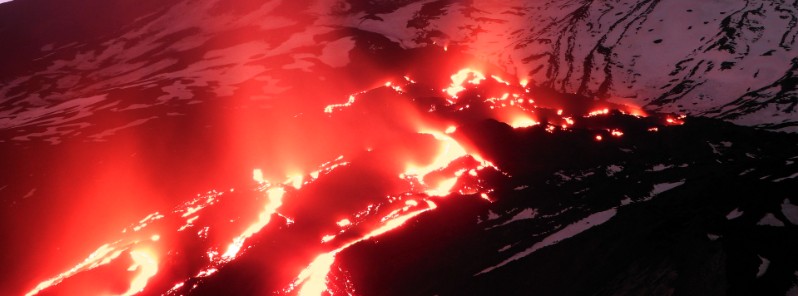Effusive eruption with active lava flow continues at Etna volcano, Italy since November 27, 2022.
Slow and silent eruption for more than a month has been a delight to those living around the volcano, INGV’s Boris Behncke said on January 2, 2023.
“This for me is one of the most fascinating aspects of Etna — how the activity can be different, from the dramatic and violent paroxysms of last year to this totally calm, sweet activity, which does not create the slightest problem, a minimum pre-occupation,” Behncke said.1
“I too, a lover of explosive activity, cherish this kind of eruption so much, because it doesn’t force you to spend a frozen night waiting for a paroxysm that hesitates to come, and then passes away in an instant… Instead, you go up at sunset in a beautiful panoramic spot, you enjoy lights and colors, take pictures and videos, and return home in time for dinner. Marvel.”
This new fissure vent opened at the northeastern base of Etna’s SE crater on November 27, 2022:
Geological summary
Mount Etna, towering above Catania, Sicily’s second-largest city, has one of the world’s longest documented records of historical volcanism, dating back to 1500 BCE.
Historical lava flows of basaltic composition cover much of the surface of this massive volcano, whose edifice is the highest and most voluminous in Italy.
The Mongibello stratovolcano, truncated by several small calderas, was constructed during the late Pleistocene and Holocene over an older shield volcano. The most prominent morphological feature of Etna is the Valle del Bove, a 5 x 10 km (5.1 x 6.2 miles) horseshoe-shaped caldera open to the east.
Two styles of eruptive activity typically occur at Etna. Persistent explosive eruptions, sometimes with minor lava emissions, take place from one or more of the three prominent summit craters, the Central Crater, NE Crater, and SE Crater (the latter formed in 1978).
Flank vents, typically with higher effusion rates, are less frequently active and originate from fissures that open progressively downward from near the summit (usually accompanied by strombolian eruptions at the upper end).
Cinder cones are commonly constructed over the vents of lower-flank lava flows. Lava flows extend to the foot of the volcano on all sides and have reached the sea over a broad area on the SE flank.2
1 Boris Behncke – Facebook – January 2, 2022
2 Etna – Geological summary – GVP

